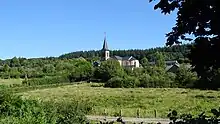France profonde
La France profonde ("Deep France") is a phrase that denotes the existence of "deep" and profoundly "French" aspects in the culture of French provincial towns, of French village life and rural agricultural culture, which escape the "dominant ideologies" (Michel Dion's expression) and the hegemony of Paris (as well as other major cities).

The term was made familiar to English readers in Dion's 1988 radical critique La France profonde, predicting a union of de-communised socialism with a reformed Catholic Church.[2] Although he used the historical regions of Lorraine and Mayenne as examples in his book, the term can be applied more widely. It was further popularised in Celia Brayfield's Deep France: A Writer's Year in La France profonde (2004) retitled in paperback Deep France: A Writer's Year in the Béarn. "Deep France" is seen to be profoundly localist in outlook and to be receding in the face of international mass culture. The term remains used in national politics, especially since the first election of Emmanuel Macron as President of France, which led to the subsequent yellow vests movement,[3][4] which demanded, among other goals, an improved standard of living and improved government services for rural areas.
Albert Kahn's photographic and cinematographic studies at the beginning of the 20th century possibly for the first time helped depict French provincial life and in doing so gave some vision into "Deep France".
References
- "BOURGOGNE : la région du président. NIÈVRE : terre de mission pour l'opposition", Le Monde (in French), 9 March 1982.
- Dion, Michel. La France profonde (1988). Messidor, Paris. 247 pp.
- "Emmanuel Macron courts the countryside", Politico Europe, 8 December 2021.
- "Présidentielle 2022 : "La France profonde est en train de se réveiller", dit Aliot, soutien de Le Pen", RTL (in French), 11 April 2022.